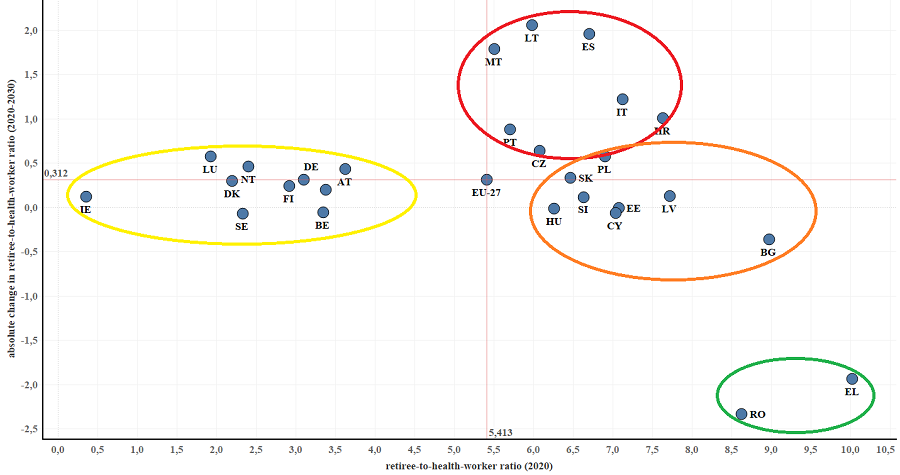Analysis from the Cedefop skills forecast shows that in most countries with a growing elderly population, health sectors are not expected to expand accordingly by 2030.
The coronavirus pandemic has highlighted the health sector’s importance for the prosperity of countries across the world. Health professionals and associates, technicians, personal service workers, as well as cleaners and helpers, are still engaged in a non-stop fight against the pandemic. However, demand for employment in the sector was steadily growing for a long time before the pandemic, reflecting the efforts to care for an ageing population across the EU. This rising demand, coupled with the fact that healthcare professionals and technicians belong to the occupational groups least likely to be automated in Europe, implies that the health sector is a cornerstone of future employment demand in Europe.
Recent Cedefop work has highlighted the need for critical investment in the health sector. Ageing has been long identified as a particularly cumbersome challenge for the EU-27. In 2018, people aged 55 or more accounted for almost one third of the total EU population, while in 2020 the average old-age dependency ratio, a relative measure of the size of the age groups not working (65+) and the persons in working age (15-64), was about 32% and it is forecasted to increase to almost 40% by 2030. Apart from affecting Member States in terms of financial sustainability, ageing requires increasing investment in the health sector to serve the needs of a growing number of older people. As Member States are not ageing with the same pace, we should anticipate that, other things being equal, future employment demand projections for the health sector would go together with the intensity of population ageing in different countries.
How are countries investing in health?
To capture the extent of preparedness of country health sectors to cope with ageing, Cedefop constructed a ratio of each country’s population over 65 to the employment levels in the health sector, as it is estimated by the latest skills forecasts. This ratio shows the number of people aged 65+ per health-related employee in each country.
Figure 1 pits the 2020 level of this retiree-to-health-worker ratio against its absolute change between 2020 and 2030, so it shows what is the situation today and how it is expected to evolve in the next 10 years.
We can distinguish four groups of countries. The health sectors in Romania and Greece (green circle) seem to face the most intense pressure by population ageing, but this pressure is expected to be significantly reduced by 2030. This can be attributed to the large expansion of the health sector (over 40%, see Figure 2) forecasted in these countries by 2030.
Figure 1: Ratio of population aged 65+ to employment in the health sector: 2020 level and absolute change 2020-30

On the other hand, there is a large group of countries (red circle) comprising mostly Eastern European ones such as Lithuania and Czechia, as well as Italy, Spain and Portugal, for which ageing is intense today (retiree-to-health-worker ratio was above the EU-27 level in 2020), and the situation is expected to heavily amplify by 2030. For example, in Lithuania and Spain by 2030 there are expected to be two more persons aged 65+ for each health worker than today. This is a result of the forecasted shrinking of the health sector (see Figure 2). One would instead expect that these countries would invest more in their health sector to cope with the already intense ageing. For all other countries in this group the size of the health sector does not change by 2030, indicating a similar inactivity in coping with ageing.
Figure 2: Percentage growth in health sector employment, 2020-30

The third group (orange circle) consists of countries facing relatively intense ageing today and making efforts to reduce the problem by expanding their health sectors. This is expected to prevent the retiree-to-health-worker ratio from increasing extensively (e.g. for Slovenia, Hungary and Latvia) or lead to a slight decrease (for Bulgaria) by 2030.
The last group (yellow circle) consists of countries for which the health sector does not appear to be under pressure by ageing, either today or in 10 years’ time. For these countries there are today significantly less retirees per health worker than the EU-27 average, and the ratio is either expected to increase only slightly (e.g. France, Denmark, Germany, Ireland) or even decrease (Sweden, Belgium). Figure 2 shows that the heath sector in most of these countries is predicted to expand more than the EU-27 aggregate of 10.1% by 2030.
Elderly can benefit from post-pandemic investment
The need for investment in health across the EU was made more apparent than ever during the pandemic. Cedefop expert responsible for the skills forecast Ilias Livanos notes: ‘Although the rising demand for health services is now well documented in our projections, the future demand for health does not seem to consider ageing to the extent that it should. The determination of several EU countries to further invest in health to strengthen resilience in a post-pandemic world could result in “feeding two birds with one scone” if population ageing is also considered as a factor when determining future investment. Stronger resilience of a country’s health system can and should go hand-in-hand with adequately meeting the needs of its elderly population.’




